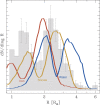The Nature and Origins of Sub-Neptune Size Planets
- PMID: 33680689
- PMCID: PMC7900964
- DOI: 10.1029/2020JE006639
The Nature and Origins of Sub-Neptune Size Planets
Abstract
Planets intermediate in size between the Earth and Neptune, and orbiting closer to their host stars than Mercury does the Sun, are the most common type of planet revealed by exoplanet surveys over the last quarter century. Results from NASA's Kepler mission have revealed a bimodality in the radius distribution of these objects, with a relative underabundance of planets between 1.5 and 2.0 . This bimodality suggests that sub-Neptunes are mostly rocky planets that were born with primary atmospheres a few percent by mass accreted from the protoplanetary nebula. Planets above the radius gap were able to retain their atmospheres ("gas-rich super-Earths"), while planets below the radius gap lost their atmospheres and are stripped cores ("true super-Earths"). The mechanism that drives atmospheric loss for these planets remains an outstanding question, with photoevaporation and core-powered mass loss being the prime candidates. As with the mass-loss mechanism, there are two contenders for the origins of the solids in sub-Neptune planets: the migration model involves the growth and migration of embryos from beyond the ice line, while the drift model involves inward-drifting pebbles that coagulate to form planets close-in. Atmospheric studies have the potential to break degeneracies in interior structure models and place additional constraints on the origins of these planets. However, most atmospheric characterization efforts have been confounded by aerosols. Observations with upcoming facilities are expected to finally reveal the atmospheric compositions of these worlds, which are arguably the first fundamentally new type of planetary object identified from the study of exoplanets.
© 2020. The Authors.
Figures








References
-
- Adams, F. C. , Batygin, K. , Bloch, A. M. , & Laughlin, G. (2020). Energy optimization in extrasolar planetary systems: The transition from peas‐in‐a‐pod to runaway growth. Monthly Notices of the Royal Astronomical Society, 493(4), 5520–5531. 10.1093/mnras/staa624 - DOI
-
- Adams, E. R. , Seager, S. , & Elkins‐Tanton, L. (2008). Ocean planet or thick atmosphere: On the mass‐radius relationship for solid exoplanets with massive atmospheres. The Astrophysical Journal, 673, 1160–1164. 10.1086/524925 - DOI
-
- ALMA Partnership , Brogan, C. L. , Pérez, L. M. , Hunter, T. R. , Dent, W. R. F. , Hales, A. S. , et al. (2015). The 2014 ALMA long baseline campaign: First results from high angular resolution observations toward the HL Tau region. The Astrophysical Journal Letters, 808(1), L3 10.1088/2041-8205/808/1/L3 - DOI
-
- Andrews, S. M. , Huang, J. , Pérez, L. M. , Isella, A. , Dullemond, C. P. , Kurtovic, N. T. , et al. (2018). The disk substructures at high angular resolution project (DSHARP). I. Motivation, sample, calibration, and overview. The Astrophysical Journal Letters, 869(2), L41 10.3847/2041-8213/aaf741 - DOI
-
- Andrews, S. M. , Wilner, D. J. , Hughes, A. M. , Qi, C. , Rosenfeld, K. A. , Öberg, K. I. , et al. (2012). The TW Hya disk at 870 μm: Comparison of CO and dust radial structures. The Astrophysical Journal, 744(2), 162 10.1088/0004-637X/744/2/162 - DOI
Publication types
LinkOut - more resources
Full Text Sources
Other Literature Sources
Research Materials
Miscellaneous
